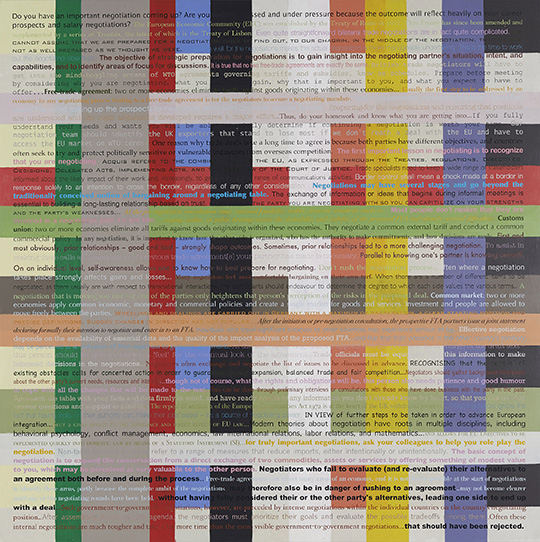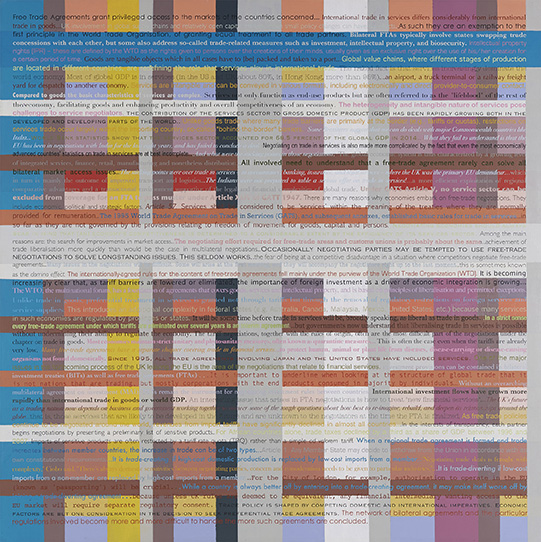 home
about
artists
exhibitions press
contact
purchase
home
about
artists
exhibitions press
contact
purchase |
|
|
LARRY McGINITY Art as a Derivative IV – The Art of Trade Negotiation
Chances are, despite your years of training, you've never had a course in how to negotiate. Recent events indicate that even before the historic process of the UK's separating from the EU officially starts, the climate in which the negotiations take place can all too easily become fraught and fractious. The UK's ability to secure a new and mutually beneficial relationship with the EU will have enormous implications. Then, over the next five to ten years there is the process of establishing new trade arrangements with non-EU states and a host of already established trade blocs around the world. Here negotiators will not only have to overcome barriers to trade, but will also have to comprehend and resolve any cultural differences they encounter. Recent events and developments have repositioned etiquette and intercultural communication as fundamental topics requiring critical analysis... Art as a Derivative IV – The Art of Trade Negotiation identifies the danger areas that lie at the heart of the trade negotiating process. The eight artworks in the series suggest strategies to avoid and resolve misunderstandings – be they cultural or even personal – between negotiators, whatever their seniority and depth of experience. In a sense, the bright and dynamic paintings that make up The Art of Trade Negotiation constitute a unique course in how to succeed in trade deals.
Can you recover from perfectionism and change your ways? The first thing you have to do is admit that your perfectionism may be a problem. In the immediate aftermath of the June 23rd referendum on EU membership, Art as a Derivative embarked on a deep exploration of the rules and regulations, opinions and prejudices integral to trade negotiations. Particular attention was also paid to EU protocols and directives in the trade sphere and the rules governing World Trade Organization membership. Vital concepts such as Rules of Origin and Most-Favoured-Nation status were explored. Many people have a very strong need to be liked by the person they are negotiating against. This has dangerous implications... Art as a Derivative is impelled to make a new type of art – which might be called art reportage – driven by the heightened impact of the 2008 financial crisis on all aspects of decision-making across social, political and cultural affairs. Art as a Derivative's inspiration and energy flow directly from analysing real-time events in the external world as they unfold.
At a time in the global economic cycle when many countries are keen to protect their own economies, it is all too easy to lose sight of how important it is to remain internationally focused with regard to trade. In the giddy, non-stop, multi-channel news cycle, Art as a Derivative makes art through a paradox – by holding up the essence of the most challenging issues of our time and turning them into a form of 21st-century hieroglyphics. ...Weaker parties therefore face a dual challenge: they must both advance their interests in the rule-making negotiations and also increase the security of agreements. Art as a Derivative has a proven track record in anticipating economic and political trends. And perhaps international trade policy is the sphere, right now, that impacts the global population more than any other; here the artist can play a vital role. Don't do something in the short run that will come back to hurt you in the long run, that's not smart negotiation... The Art of Trade Negotiation required a research process in which tens of thousands of lines of verbatim text were read and sifted. Texts originating from diplomatic sources, global trade negotiators, academic conferences, leading legal and constitutional opinion as well as financial journalists and deal-making gurus were compiled. In a strict sense every free-trade agreement under which tariffs are eliminated over several years is an interim agreement... In one very real sense, the words themselves, their tone and stance, became my palette. I identified eight key themes that will be essential in reshaping the UK's relationship with the EU and will, in a wider sense, say much about the national self-image negotiators are aiming to present to the world. Understanding the purpose of trade agreements has immediate implications for how trade negotiations are conducted... Art as a Derivative IV – The Art of Trade Negotiation is unique: it combines a highly analytical approach to the negotiating process, whilst remembering that the critical importance of these talks will not protect them from becoming mired in the detail and legal code that is particular to formal free trade agreements. ...Always cooperate, until provoked; if provoked, always retaliate with equal force; be quick to forgive. In short, the whole thing could become so turgid that anyone not involved with or directly implicated in the talks could lose interest; and this in turn could have a serious impact on outcomes. How confidential is the information you are sharing? As a general rule, openness within government circles is important, but obviously details of negotiating strategies should not be available for all to see... Each of the eight 1-metre-square paintings explores a different aspect of the negotiating process in some 1,500 words of verbatim text. These texts are crafted into "dialogues" where opinion, past experience, rules and regulations and headlines meet and connect over a grid of intersecting brightly coloured columns.
Running through each artwork is a story or narrative line, and to maintain this visually is essential. Each separate opinion, headline or statement has its own typeface and colour, so that the viewer can follow each thread of the discussion as it develops.
Avoid Escalations: When negotiations
become heated take a break or use humour to defuse the situation. Companies recognise that if one of their suppliers fails, this will have an operational impact on their own production and may result in their own failure to meet obligations. All quotes will be comprehensively credited in an accompanying catalogue. And remember, when embarking on trade talks, it's always best to go into negotiations knowing what alternatives you have... Larry McGinity, 2017 |
|
|
|
E-mail: info@hayhillgallery.com |



 An
important determinant of the outcome of bargaining is the extent to
which information about various variables (or factors) are known to
all the parties in the bargaining situation.
An
important determinant of the outcome of bargaining is the extent to
which information about various variables (or factors) are known to
all the parties in the bargaining situation.